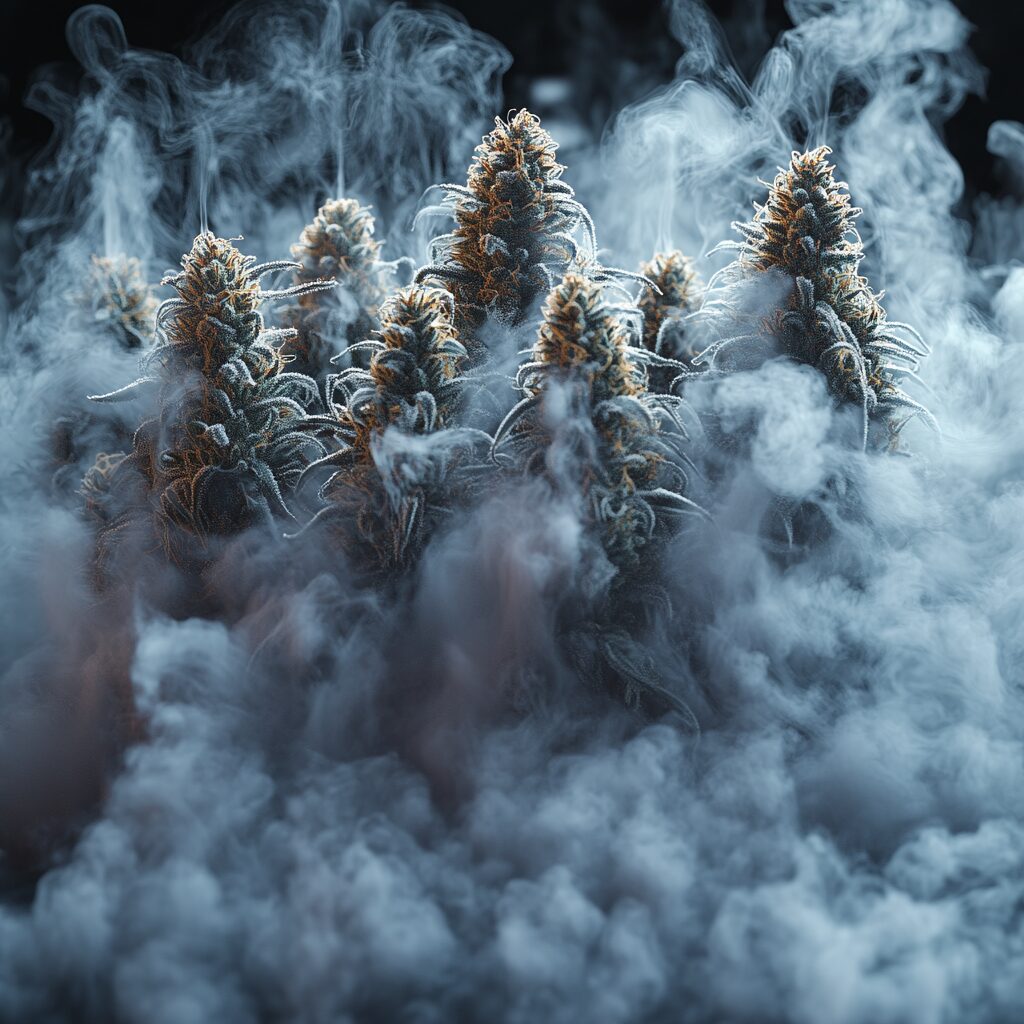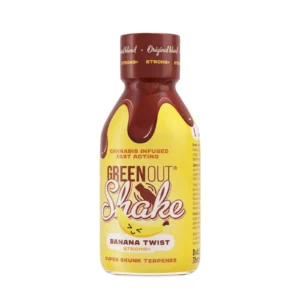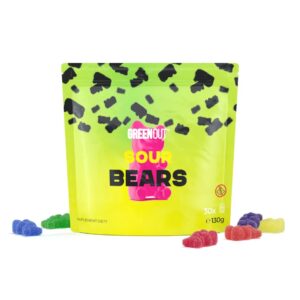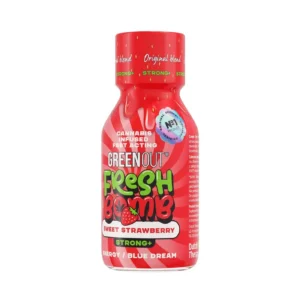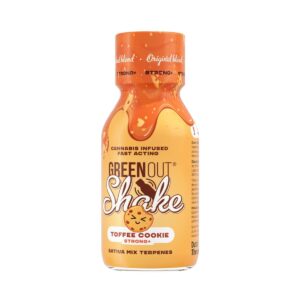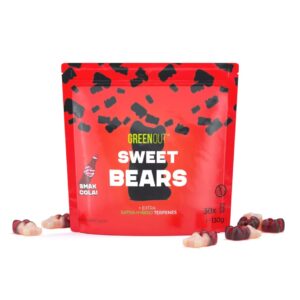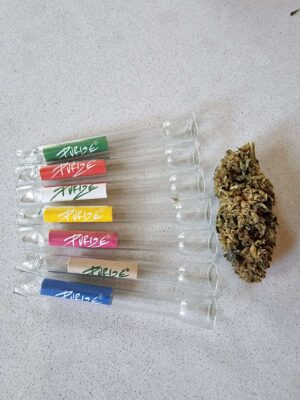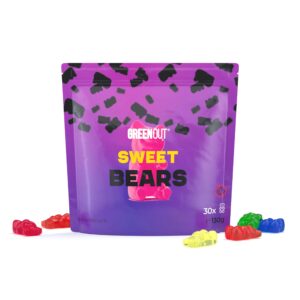ABV - Treasure after vaporization
If you're a fan of cannabis vaporization, you've probably noticed that after each session, a brown, dry dried material is left in the chamber of the vaporizer. That's ABV (Already Been Vaped), a material that many throw away, not realizing that it still harbors potential. ABV contains residual cannabinoids such as THC and CBD, making it a great raw material for further use, such as in cooking, cosmetics or tinctures.
How do you collect and prepare ABV dried food?
Understanding the vaporization process and the formation of ABVs
ABV is formed when you vaporize marijuana - hot air vaporizes cannabinoids and terpenes, but does not remove them completely. The amount of other compounds depends:
- Temperatures: Lower temperatures (170-190°C) leave more cannabinoids, while higher temperatures (200-230°C) deplete them more, leaving, for example, the sedative CBN.
- Session time: Shorter sessions (3-5 minutes) retain more active ingredients than long ones (10+ minutes).
- Dry quality: A stronger dryer (such as 20% THC) will leave more cannabinoids in the ABV than a weaker one (10% THC).
The color of the ABV is an indication: light brown or golden means higher potency, dark brown or black - lower.
ABV dry harvesting
Collecting ABV is a simple activity, but it requires attention to maintain its quality. Here's how to do it:
- Step 1: Vaporization
- Set the vaporizer to the desired temperature (I recommend 180-200°C for balanced ABV).
- Fill the chamber with the loosely ground dried material - do not whisk it so that the air can flow evenly.
- Vaporize until the vapor becomes weak (usually 3-7 minutes, depending on your device). Don't drag out the session if you want to preserve more cannabinoids in the ABV.
- Step 2: Emptying the chamber
- Wait for the vaporizer to cool down (a few minutes) to avoid burning.
- Gently siphon ABV from the chamber onto a clean surface (such as a plate) with a toothpick or brush - avoid touching with your hands to avoid losing the oils.
- Check the color: light brown is a good sign, black means that the dryer is too "burnt" and less useful.
- Step 3: Segregation (optional)
- If you vaporize at different temperatures, segregate ABVs by session (e.g. "190°C" and "220°C"). You can use separate jars, which will make it easier to experiment with potency later.
ABV storage
- Basic storage: Transfer the ABV to an airtight jar (preferably made of dark glass) and keep in a cool, dark place (such as a refrigerator). This protects the cannabinoids from degradation and prevents mold.
- Labeling: Record the date and temperature of vaporization on the jar - this will help keep track of potency and freshness.
- Long-term storage: If you have a lot of ABV, freeze it in an airtight container - it can last for months without losing quality.
Preparation of ABV for further use
ABV is already decarboxylated (activated by the heat of the vaporizer), so you can use it right away, but a few techniques can improve its quality:
- Grinding:
- Grind ABV to a fine powder in a coffee grinder or mortar. The finer consistency makes it easier to extract cannabinoids in recipes or tinctures.
- Note: Don't grind for too long to avoid overheating the dry and losing the oils.
- Water curing (optional):
- Purpose: Removes bitter, burnt aftertaste and improves odor without significantly affecting cannabinoids.
- Process:
- Pour the ABV into a jar with water (use a strainer or tea bag to more easily separate the dryness).
- Urinate for 3-7 days, changing the water every 24 hours - the longer, the milder the taste.
- Drain and dry in the oven on 90°C for 1-2 hours, until dry but not burnt.
- The effect: ABV becomes more neutral in taste, ideal for food or drinks.
- Sorting:
- If you have an ABV mixture of different potencies, you can sift it through a fine sieve to separate the larger pieces (less vaporized) from the dust (more used).
Practical tips
- Control the temperature: Experiment with your vaporizer settings (e.g. 185°C for milder ABV, 210°C for stronger CBN).
- Cleanliness: Regularly clean the vaporizer so that residual oils do not affect the taste of ABV.
- Quantity: Collect ABV from several sessions to have enough for larger projects (e.g., 10-15 g per cannabinoid butter).
- Testing: Test a small portion (e.g., 0.5g) before large use to assess potency - ABV is less predictable than fresh dried.
How to collect and prepare dried ABV - Details and tips
Why collect ABV?
ABV is an eco-friendly and economical solution for marijuana users. Instead of throwing away "used" dried cannabis, you can use it in recipes (e.g. butter, cookies), beverages (tea, milk), cosmetics (ointments) or even as fertilizer. ABV is estimated to retain 10-30% of its original cannabinoids, making it a milder but still valuable material.
How does vaporization affect ABV?
Vaporization vaporizes cannabinoids and terpenes in a controlled manner, unlike smoking, which burns most of the compounds. Temperature is key:
- 170-190°C: It retains more THC and CBD, ideal for those who want psychoactive effects from ABV.
- 200-230°C: It leaves more CBN, which gives a more sedative effect, but less of a "high."
The time of the session also matters - shorter vaporization (until the vapor weakens) leaves more cannabinoids than long ones, until the dried product is completely "burned".
ABV collection in practice
The collection process is simple, but requires a few rules:
- Equipment: Use a vaporizer with an easy to empty chamber (e.g., Mighty, Pax, Volcano).
- Technology: Don't compact the dryer in the chamber - a loose arrangement ensures even vaporization and easier ABV removal.
- Frequency: Collect ABV after each session to avoid moisture buildup in the device.
ABV Preparation - Key to Success
ABV straight from the vaporizer has an earthy, sometimes bitter aftertaste, which can be a deterrent when eating or drinking. That's why preparation, such as "water curing" or grinding, is so important:
- Water curing: This process removes the water-soluble compounds that are responsible for the bitterness, leaving the cannabinoids (fat- and alcohol-soluble).
- Grinding: The fine powder increases the contact surface with fats or alcohol, which improves extraction in recipes.
How to evaluate the quality of ABV?
- Color: Light brown = more cannabinoids, dark brown/black = less.
- Fragrance: Slightly nutty smell suggests good quality, burnt or chemical - excessive vaporization.
- Test: Sprinkle 0.5 g of ABV on a peanut butter sandwich and eat - if you feel the effects after 1-2 hours, ABV is worth the effort.
Potential applications
Once the ABV is collected and prepared, you can use it to:
- Cannabinoid butter (cannabutter) for cakes or brownies.
- Tea or milk with ABV for relaxation.
- Skin ointment for muscle pain.
- Alcoholic tinctures for quick action.
Tips and warnings
- Adjust vaporization: If you plan to use ABV, vaporize at lower temperatures to leave more cannabinoids.
- Hygiene: Clean the vaporizer regularly so that the ABV does not get an aftertaste of old oils.
- Legality: Ensure that ABV collection and use is in compliance with local marijuana laws.
- Patience: ABV preparation (e.g., "water curing") takes time, but improves its quality.
- ABV power: 10-30% of primary cannabinoids, dependent on temperature (170-190°C = more THC, >200°C = more CBN) and session time.
- Collection: Gentle emptying of the chamber and control of vaporization is key.
- Preparation: Grinding increases extraction, "water curing" removes bitterness (3-7 days, drying at 90°C).
- Storage: Airtight jars in the refrigerator or freezer for long-term freshness.
ABV collection and preparation is a simple process that requires attention to temperature, technique and storage. This allows you to turn "waste" into a valuable raw material for further use.
ABV (Already Been Vaped) dried cannabis is more than just leftovers after vaporization - it's a chance to put cannabis to creative use that you don't want to waste. After vaporization, cannabinoids such as THC and CBD remain in the dried cannabis, making it a valuable material for culinary experiments, relaxing drinks, homemade cosmetics, and even unusual uses like natural fertilizer. In this extended article, you'll find a detailed guide to ABV, new recipes and practical tips to help you realize its full potential. Ready to look at this brown dust in a whole new light?
How to use the ABV drought?
Understanding ABV - What is left after vaporization?
ABV is a dried product that has undergone a vaporization process, during which the cannabinoids and terpenes have been partially vaporized. However, not everything disappears - the remaining content depends on several factors:
- Vaporization temperature: Lower temperatures (170-190°C) leave more THC and CBD, while higher temperatures (200-230°C) deplete them more, leaving mainly CBN (a cannabinoid with sedative effects).
- Session time: Short sessions (3-5 minutes) retain more cannabinoids than long sessions (10+ minutes).
- Initial dry quality: A high THC dryer (e.g. 20-25%) will leave more active compounds than a weaker one (10-15%).
- Color as an indicator: Light brown or golden ABV suggests higher potency, dark brown or black - lower.
ABV is estimated to contain 10-30% of primary cannabinoids, making it milder but still useful. Interestingly, ABV is already decarboxylated (heat-activated), so it does not require additional heating before use in edibles.
Storage and preparation
- Basic storage: Keep ABV in an airtight jar in a cool, dark place (such as a refrigerator) to protect cannabinoids from degradation and prevent mold.
- Batch labeling: If you vaporize at different temperatures, label the jars (e.g. "190°C" or "220°C"), which will make it easier to evaluate the potency when you use it later.
- Water curing: This is an advanced technique to improve the taste and aroma of ABV. Soak the dryer in water for 3-7 days, changing the water every 24 hours, then dry in the oven at 90°C for 1-2 hours. This removes the bitterness and residual burnt aftertaste without significantly affecting the cannabinoids.
- Grinding: For better extraction in recipes, grind the ABV into a fine powder with a coffee grinder or mortar.
Uses
- Edibles: ABV can be added to butter, oil, sprinkled on food or used in baked goods - perfect for those who enjoy culinary experiments.
- Refreshments: Prepare tea, milk, coffee or cocktails with ABV for a mild, relaxing effect.
- Tinctures: Soak ABV in high alcohol (such as spirit) to create a tincture for use under the tongue or as a drink additive.
- Capsules: Grind ABV and pour into gel capsules - discreet and easy to dose.
- Cosmetics: Infuse ABV in oils (e.g. coconut, almond) into ointments, lotions or oils on the skin.
- Smoking or re-vaporizing: ABV can be smoked in a joint, bong, or re-vaporized at a higher temperature (e.g. 220°C), although the effects and flavor will be weaker.
- Unusual applications: Use ABV as a natural fertilizer for plants (rich in nitrogen) or add to compost - eco-friendly and practical!
Practical tips
- Taste: ABV has an earthy, sometimes bitter aftertaste - mask it with fatty ingredients (butter, chocolate) or spices (cinnamon, vanilla). "Water curing" significantly improves the taste experience.
- Dosage: Start with 0.5-1 g, especially with edibles, and wait 1-2 hours for effects. ABV is less predictable than fresh dried, so caution is key.
- Extraction: Fats (butter, oil, milk) increase the bioavailability of cannabinoids, so combine ABV with such ingredients for better results.
- Creativity: Experiment with proportions and methods - ABV is the stuff of fun and discovery!
Recipes with dried ABV
ABV butter (Cannabutter)
A versatile ingredient for cooking and baking.
Ingredients:
- 10-15 g ABV (finely ground)
- 1 cup unsalted butter (about 230 g)
- 1 cup of water
- Optional: pinch of salt (if you like the taste)
Instructions:
- Melt butter in a saucepan over low heat, add water and pour in ABV.
- Cook on minimal heat for 2-3 hours, stirring every 20-30 minutes to avoid burning. Water prevents overheating.
- Strain through gauze or a fine strainer into a container, squeezing out any remaining liquid.
- Chill in the refrigerator for 2-3 hours until the butter hardens, then remove the remaining water from the bottom.
Application: Use 1-2 teaspoons per serving in brownie, on toast, in sauces or even for sautéing vegetables. Store in the refrigerator for up to 2 months or freeze for longer.
Firecrackers from the ABV
A quick, simple snack for lazy foodies.
Ingredients:
- 2 graham crackers (or regular crackers/biscuits)
- 0.5-1 g ABV
- 2 tablespoons of peanut butter (preferably natural)
- 1 tsp melted chocolate or honey (optional)
Instructions:
- Preheat the oven to 120°C.
- Spread both crackers with peanut butter, sprinkle ABV evenly on one of them.
- Pour melted chocolate or honey for flavor, fold the crackers into a "sandwich".
- Wrap in aluminum foil and bake for 20-25 minutes.
- Cool for 10 minutes and eat - start with half to evaluate the effects.
Attention: The fat in peanut butter promotes the extraction of cannabinoids, and the chocolate masks the bitterness of the ABV.
Tea with ABV
A warm drink for a relaxing evening.
Ingredients:
- 2-3 g ABV
- 1 cup of hot water
- 1 tablespoon of whole milk or cream (optional)
- Extras: lemon zest, cinnamon stick, honey or ginger
Instructions:
- Pour ABV into a tea bag, brewer or directly into a cup.
- Pour hot water (not boiling water, about 85-90°C), add milk/cream for better extraction.
- Brew for 7-10 minutes, stirring occasionally.
- Add spices or honey of your choice, strain (if you don't use a bag) and drink slowly.
Application: Ideal for subtle relaxation - start with half a glass to assess the strength.
Ointment with ABV
Home cosmetic for topical ailments.
Ingredients:
- 10-15 g ABV
- 1/2 cup coconut oil
- 2 tablespoons of beeswax
- 5-10 drops of essential oil (e.g. lavender, eucalyptus)
Instructions:
- Melt coconut oil and beeswax in a water bath over low heat.
- Add ABV and cook on minimal heat for 1-2 hours, stirring every 15 minutes.
- Strain through gauze into a jar, add essential oil while the mixture is still warm.
- Set aside to set at room temperature (about 1-2 hours).
Application: Apply a thin layer to the skin in areas of pain or irritation - it works topically, without psychoactive effects. Store up to 6 months in a cool place.
Tincture from ABV
A powerful extract for discreet use.
Ingredients:
- 10-20 g ABV
- 100-150 ml of high alcohol (such as 95% spirit or 40% vodka).
- Dark glass jar
Instructions:
- Pour ABV into a jar, pour alcohol so that it covers it completely.
- Close the jar and store in a dark, cool place for 1-2 weeks, shaking once a day.
- Strain through a coffee filter or gauze into a dropper bottle.
- Use 2-5 drops under the tongue, starting with a small dose.
Application: Fast acting (15-30 minutes), ideal for precise dosing. Store in the refrigerator for up to a year.
Chocolate balls with ABV (no baking)
A sweet snack without using the oven.
Ingredients:
- 5-10 g ABV (finely ground)
- 1/2 cup peanut butter
- 1/4 cup honey
- 1/2 cup oatmeal
- 1/4 cup cocoa powder
- 1 teaspoon vanilla extract
Instructions:
- In a bowl, mix peanut butter, honey and vanilla extract until a smooth paste forms.
- Add ABV, oatmeal and cocoa powder, mixing thoroughly until everything is combined.
- Form small balls (about 1 tablespoon of mixture per ball) and place on baking paper.
- Chill in the refrigerator for 30-60 minutes until they harden.
Application:
- Eat 1 ball to start, waiting 1-2 hours for effects.
- Store in the refrigerator for up to a week or freeze for longer.
Notes:
- Intense chocolate and peanut butter flavors mask the ABV.
- Great for beginners - easy and tasty.
- Dosage: ABV is unpredictable - start with 0.5-1 g with edibles and wait 1-2 hours for effects, which can last 4-8 hours. For tinctures, test 2-3 drops.
- Legality: Check local regulations for marijuana and its derivatives, such as ABV, before use.
- Taste and smell: "Water curing" removes bitterness, but without it combine ABV with oily, aromatic ingredients (e.g. chocolate, peanut butter, spices).
- Safety: Keep ABVs and finished products away from children and animals. Label them clearly to avoid confusion.
- Ecology: If you don't want to use ABV, add it to the compost - it breaks down naturally and enriches the soil.
| Recipe | Main ingredients | Preparation time | Application |
|---|---|---|---|
| Butter from ABV | ABV, butter, water | 2-3 hours | Baked goods, spreads |
| Firecrackers from the ABV | ABV, crackers, peanut butter | 30 minutes (with baking) | Quick snack |
| Tea with ABV | ABV, water, milk, spices | 10 minutes | Relaxing drink |
| Ointment with ABV | ABV, coconut oil, beeswax | 1-2 hours | For skin, pain relief |
| Tincture from ABV | ABV, alcohol | 1-2 weeks | Sublingual, precise dosage |
